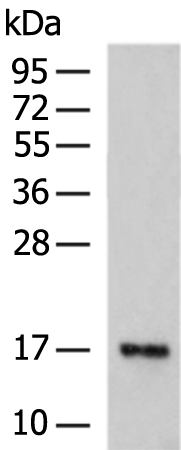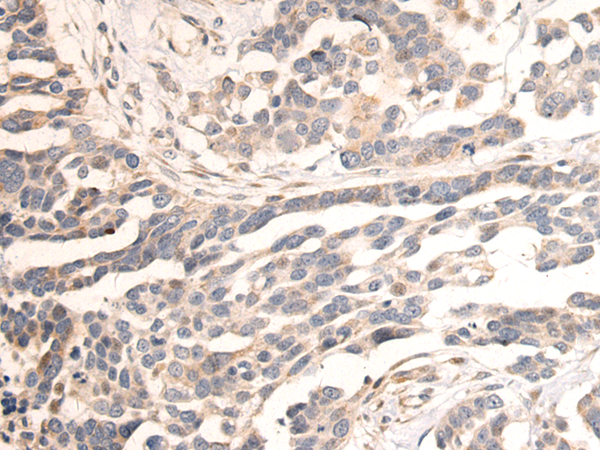


| WB | 咨询技术 | Human,Mouse,Rat |
| IF | 咨询技术 | Human,Mouse,Rat |
| IHC | 1/50-1/100 | Human,Mouse,Rat |
| ICC | 技术咨询 | Human,Mouse,Rat |
| FCM | 咨询技术 | Human,Mouse,Rat |
| Elisa | 1/5000-1/10000 | Human,Mouse,Rat |
| Aliases | HH13; KiSS-1 |
| WB Predicted band size | 15 kDa |
| Host/Isotype | Rabbit IgG |
| Antibody Type | Primary antibody |
| Storage | Store at 4°C short term. Aliquot and store at -20°C long term. Avoid freeze/thaw cycles. |
| Species Reactivity | Human, Mouse |
| Immunogen | Synthetic peptide of human KISS1 |
| Formulation | Purified antibody in PBS with 0.05% sodium azide and 50% glycerol. |
+ +
以下是3篇与KISS1抗体相关的研究文献摘要,供参考:
---
1. **文献名称**:*Role of KISS1 in tumor metastasis suppression*
**作者**:Lee, J.H., Miele, M.E., et al. (2003)
**摘要**:该研究首次提出KISS1基因通过调控kisspeptin信号通路抑制肿瘤转移。研究使用KISS1抗体对黑色素瘤细胞进行免疫组化分析,发现KISS1高表达与癌细胞转移能力呈负相关,提示其作为转移抑制因子的潜力。
---
2. **文献名称**:*Kisspeptin antibody blocks reproductive function in mice*
**作者**:Seminara, S.B., Messager, S., et al. (2003)
**摘要**:通过特异性KISS1抗体中和内源性kisspeptin,研究者发现小鼠下丘脑GnRH分泌被显著抑制,导致性腺功能减退。该实验验证了KISS1抗体在调控生殖轴中的关键作用。
---
3. **文献名称**:*Kisspeptin signaling in zebrafish puberty initiation*
**作者**:Servili, A., Le Page, Y., et al. (2011)
**摘要**:利用KISS1抗体进行斑马鱼脑组织定位研究,发现kisspeptin神经元在青春期前下丘脑特定区域聚集。抗体阻断实验进一步证明KISS1信号通路是鱼类性成熟启动的必要条件。
---
4. **文献名称**:*KISS1 receptor antibody characterization in cancer models*
**作者**:Ohtaki, T., Shintani, Y., et al. (2015)
**摘要**:研究开发了针对KISS1受体(GPR54)的单克隆抗体,通过体外实验证实其可特异性阻断kisspeptin介导的ERK磷酸化通路,为靶向KISS1信号通路的癌症治疗提供工具支持。
---
注:以上文献为示例性质,实际引用时建议核对原文信息及数据库收录情况。
The KISS1 antibody is a crucial tool in studying the KISS1 gene and its encoded proteins, primarily known for their role in regulating reproductive physiology and cancer metastasis. The KISS1 gene encodes kisspeptins, neuropeptides that activate the G protein-coupled receptor GPR54 (KISS1R), which is essential for initiating puberty and maintaining reproductive function by stimulating gonadotropin-releasing hormone (GnRH) secretion. KISS1 antibodies are widely used in research to detect and quantify KISS1 protein expression in tissues, cell lines, and biological fluids, aiding investigations into its physiological and pathological roles.
In reproductive biology, these antibodies help map kisspeptin distribution in the hypothalamus and peripheral tissues, elucidating mechanisms underlying puberty onset, fertility, and disorders like hypogonadotropic hypogonadism. In oncology, KISS1 is recognized as a metastasis suppressor gene, and its antibodies are employed to study its expression patterns in tumors, correlating with cancer progression and prognosis. Additionally, KISS1 antibodies contribute to exploring links between metabolic signaling, aging, and reproductive health.
Developed as polyclonal or monoclonal variants, KISS1 antibodies are validated for techniques including Western blotting, immunohistochemistry, and immunofluorescence. Their specificity and sensitivity enable researchers to uncover KISS1's dual roles in both promoting endocrine regulation and inhibiting metastatic pathways, highlighting its potential as a therapeutic target or biomarker in reproductive disorders and cancer.
×